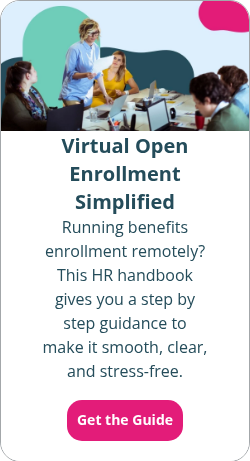How to prepare for open enrollment as an employer
By Elizabeth Walker on September 22, 2025 at 7:45 AM
If you're an employer with a limited budget, you may find it hard to offer employee health benefits. But a personalized benefits package that includes quality health coverage is necessary if you want to entice talented workers.
In today’s labor market, employees carefully consider an employer's benefits package before accepting a job. In addition to health insurance benefits, workers want benefits that enhance their mental health, improve employee satisfaction, and support a work-life balance.
Open enrollment season is the perfect opportunity to determine if your compensation package meets these demands. This article outlines five key strategies for preparing for open enrollment season and showcasing your employee benefits package.
In this blog post, you'll learn:
- What open enrollment is, how it works, and why it matters for both employers and employees.
- Five practical strategies employers can use to prepare for open enrollment and strengthen their benefits package.
- How clear communication, resources, and easy enrollment processes can improve the employee experience during open enrollment.
What is open enrollment?
Open enrollment is the dedicated window of time for Americans to enroll in, renew, or change their health coverage. If they’re seeking an individual health policy, they can do this through the Health Insurance Marketplace, state-based or private exchanges. Otherwise, enrollment varies by company.
The annual Open Enrollment period for individual plans is the only time individuals and family members enrolled in a Marketplace plan can change their current coverage outside of a special enrollment period (SEP), which requires a qualifying life event. It ensures individuals don't wait until they get sick to enroll in or switch to a more comprehensive plan.
Currently, Open Enrollment for Marketplace plans starts on November 1 and ends on January 15 in most states. However, a recent CMS final rule has changed the Open Enrollment process1. Effective beginning the 2026 Open Enrollment Period for 2027 coverage, the dates to enroll in coverage will start on November 1 and end on December 15 for all states with public exchanges operating on the federal Health Insurance Marketplace. State-based exchanges will also have to shorten their annual enrollment period to end by December 31.
Suppose you're an employer that offers a group policy through the Small Business Health Options Program (SHOP) or a private insurance carrier. In that case, your open enrollment period may be a different time of year. But, if you offer a stand-alone health reimbursement arrangement (HRA), your employees will use the ACA Open Enrollment period to enroll in or change their individual health insurance plans.
Communicating details about open enrollment ahead of time is a great way to tell employees about their coverage options.
Here are five ways to prepare for open enrollment.
1. Set your benefits budget
If you're preparing to launch a new or revamped health benefits package, you must know how much you can afford to spend. Setting a budget will keep you focused and realistic as you choose your benefits.
Health benefits are often the most expensive perk to provide. But, they're also the most desired employee benefit. According to our 2024 Employee Benefits Survey, 92% of employees rated health benefits as important. If you have the budget, splurging on this benefit can significantly increase retention and recruitment.
If you're an employer with a small budget, there are affordable alternatives to costly employer-sponsored group plans. One alternate option is an HRA. Stand-alone HRAs enable employers to provide tax-free reimbursements to their employees for their individual health plan premiums and other qualifying out-of-pocket costs.
Some examples of HRA-eligible expenses include:
- Doctor visits
- Emergency care
- Preventive care
- Over-the-counter medication
- Prescription drugs
- Mental health counseling
- Chiropractic care
If you have fewer than 50 full-time equivalent employees (FTEs), you can offer a qualified small employer HRA (QSEHRA). The QSEHRA is an affordable healthcare option for small employers seeking quality health benefits for their staff. Its simplicity makes it an excellent choice for employers offering a health benefit for the first time.
Employers of any size, including those with 50 or more FTEs, can consider an individual coverage HRA (ICHRA). An ICHRA works like a QSEHRA in that it is a more cost-effective alternative to group health insurance. But it offers greater flexibility by allowing customization by employee classes.
Suppose you're interested in a group policy but want to save on monthly premium costs by switching to a high deductible health plan (HDHP). In that case, you can supplement your group health insurance coverage with a group coverage HRA (GCHRA). With a GCHRA, you can reimburse employees on your group plan for eligible out-of-pocket costs the plan doesn't cover.
You should also budget for other fringe benefits you want to offer, like the following:
- Paid time off (PTO)
- Life insurance
- Wellness programs
- Retirement plans
- Parental leave
- Flexible work schedules
- Health savings accounts (HSAs)
- Flexible spending accounts (FSAs)
Employers pay about $13.58 per hour on average for employee benefits2. These averages vary depending on your industry and how much you choose to spend. But they're an excellent place to start when creating your benefits budget. Consider what benefits are mandatory and what voluntary benefits you want to offer to attract and retain employees.
2. Tailor your benefit options to your employees
Open enrollment season is the perfect time to review your benefits package, as it can play a major role in reducing turnover. However, this only works if your employees see value in your offerings. That's why tailoring your benefits to include the perks employees want most is essential.
Creating an employee benefits survey to gauge your staff’s satisfaction with your current benefits is a great place to start. You can also ask them what other benefits they want to see at your company. From there, review the employee feedback. This helps you customize your benefits package to meet your employees' needs.
While the annual open enrollment period at most organizations focuses on medical coverage and healthcare plans, employees expect more when they see an updated benefits package for a new plan year.
Ensuring employees understand how you support them creates trust and a great employee experience. So, it's vital to collaborate with your employees to provide benefits that offer the most value for them.
Adding or changing a few benefit selections could be the difference between retaining or losing good employees by showing them you're committed to their health and happiness.
3. Determine a communication strategy
After you choose your benefit offerings, you must communicate which benefits are available and when open enrollment will be for your organization.
Employees tend to value a variety of benefits. However, research has found that 85% of workers can find their coverage options confusing3. So, you must do more than send your employees materials and expect them to read the information at their leisure.
Simplifying your benefits options and communicating their value is an effective way to provide your employees with vital information.
Your open enrollment communication strategy should start early and span many channels, such as:
- Group meetings or town halls to discuss benefit changes and new offerings.
- Availability for one-on-one sessions with the HR team or benefits specialists to answer any questions.
- Periodic open enrollment reminders via email updates. Be sure to include key enrollment dates and specific instructions.
- Messaging that designates relevant points of contact for further questions and concerns, like your HR team, the Health Insurance Marketplace (for those offering an HRA), and benefit vendors.
Using multiple communication channels helps employees make their benefit selections on time and get their questions answered. Allow plenty of time for questions, encourage personal conversations to explore options further, and explain your benefits to those hesitant to speak up in a group setting.
If you've made any changes to your current benefits, share the updates with your employees and thank them for their input if you decide based on their feedback. Employee morale and performance significantly improve when your staff sees the value of their contribution and opinions4.
If you offer an HRA or plan to offer an HRA for the new year, you’ll want to start telling your employees about ACA Open Enrollment. That way, plan participants can find an individual health plan that works for them.
4. Provide resources to your employees
Many employers provide resources for educating employees about their benefit offerings.
These resources can include:
- Virtual information sessions, such as webinars
- Benefit fairs
- Email campaigns
- Digital enrollment kits and guides
- Health insurance marketplace updates
- Live presentations
- 1:1 benefits specialist appointments
Virtual resources are impactful because your staff can use them throughout the year, and active employees can save them for reference when the election period comes around. For example, if you have online benefits marketing materials for last year's open enrollment, you can make changes for 2025's enrollment and distribute the information well in advance.
The enrollment process for health insurance can be challenging for your employees. So, consider providing an individual health insurance broker as a resource. Brokers are health insurance experts with vast knowledge about various health coverage topics, changing health reform, and rising medical care costs to guide your employees through the process.
However, each individual plan type has many nuances, so your employees may need personalized support. Provide contact information for the marketplace, health insurance carriers, vendors, or a benefits administrator in case any of your staff need help.
If you offer an HRA with PeopleKeep by Remodel Health, our award-winning customer support and benefits team and online help center are here to help you at the click of a button. We also allow your employees to shop for and compare individual plans through our software, ensuring plan participants find the health policies that best suit them.
5. Make it easy to enroll
In the past, employers could rely on manual processes to enroll their employees in benefits. However, with many employees working from home, virtual open enrollment is the most practical option for many employers.
While the ACA’s open enrollment window is fixed, it's crucial to make enrollment in all your company's benefits easy and inclusive for your employees — no matter their location, time of day, or device.
The key to making open enrollment straightforward — whether it's enrolling for a health benefit plan on a public or private exchange or signing up to participate in your organization's perks — is meeting people where they are. In this digital age, your benefits enrollment program should be accessible via desktop or mobile device.
To achieve this, you can create a one-stop benefit offering platform for your employees to sign in and find information and resources. Your employee benefits portal should also allow them to complete the online application process and enroll in the offerings they choose on a self-service basis. Lastly, it should have links to the marketplace for health insurance enrollment and a chat feature ready to answer other benefit questions.
The goal is to direct your employees to your digital benefits platform, where they can access everything they need during the enrollment window, all in one place.
Conclusion
It's more important than ever to show your employees that you're committed to their health and well-being. Your benefits package can either reflect or detract from that commitment. By preparing early for open enrollment, you'll have time to tailor your benefits package and highlight all your available perks. This will encourage your employees to make smart decisions about their benefits.
Providing resources, communicating early, and making enrollment easy are effective strategies for helping your employees navigate their health insurance market and enhance their experience throughout the enrollment window and beyond.
This article was originally published on August 10, 2022. It was last updated on September 22, 2025.
Check out more resources
See these related articles

How brokers can prepare for open enrollment
Are you preparing for individual health insurance Open Enrollment? Get tips to streamline onboarding and support clients' employees through the process.

What happens if you miss Open Enrollment for individual health insurance?
Missed Open Enrollment for health insurance? Find out what options you have, including qualifying life events and special enrollment periods (SEPs).

A state-by-state guide to extended open enrollment periods
Did your state extend the annual open enrollment period? Find out in this comprehensive guide detailing the extended open enrollment periods across all states.



